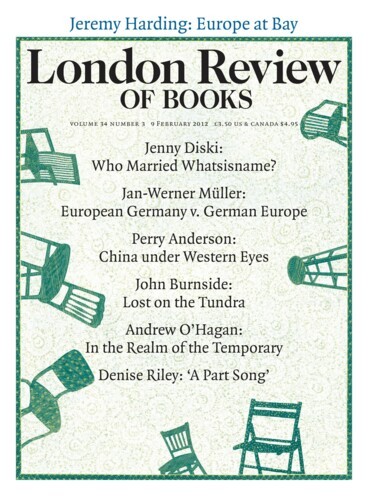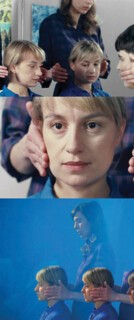‘I cannot abide fuzzy plants, or plants of a certain texture … Just looking at them sets me off,’ an off-screen male synaesthete complains in Daria Martin’s Sensorium Tests, the central work among the US-born and UK-based artist’s 16-mm films at the MK Gallery in Milton Keynes (until 8 April). I suppose many or most of us nurse comparable sensitivities to those of the young man whose words Martin took from an internet discussion of synaesthesia. (Mine are vegetal too: I have a thing about rhubarb leaves, not to speak of certain stalky umbellifers – cow parsley and the like. I blame the memory of frilled and succulent Triffids in a television adaptation of John Wyndham in the early 1980s.) But what if these aversions turned more physically insistent and unsettling? Imagine a world in which the mere sight of a pen or pencil triggered a pricking of your thumbs, in which you felt fork tines rip your flesh from across the room and the corners of hardback books poke you dully in the ribs.
These last sensations, also reported online, were noted by Martin in the course of her research. Not for the first time in her work – having trained as a painter, Martin has been making film installations since 2000 – she was taken by the threatening or tender encounter between body and thing. More precisely, she became interested in the curious phenomenon of mirror-touch synaesthesia: a condition in which the patient, faced with another human body (or even an inanimate object) that is being touched, feels this touch in the same spot on his or her body. This opens up, as they say, a world of hurt. In the presence of real violence mirror-touch synaesthetes may feel themselves slapped, punched or stabbed, and experience similar shocks when watching television or a film. Strangely, they will only feel, or fully feel, such sensations as they have already experienced: if they’ve never been passionately kissed, or kicked in the groin, the synaesthetic response recalls instead the closest analogue.
Whatever complex of psychology, neurological oddity and old-fashioned squeamishness is at work here, it seems of a piece with synaesthesia as we ordinarily understand it. That is, the kind of confusion between sense perceptions which Nabokov wrote about in Speak, Memory: ‘I present a fine case of coloured hearing.’ Nabokov claimed it gave him no advantage as a writer, but as Martin points out in the exhibition catalogue (where she quotes from, among others, Proust, Eisenstein, Benjamin and Merleau-Ponty), synaesthesia has long been thought at least an adjunct to the work of literature, painting and latterly cinema. Sensorium Tests, however, is no swooning meditation on artistic susceptibilities. Martin has in part reconstructed a clinical scene: a self-declared mirror-touch synaesthete (here played by the Romanian actress Anamaria Marinca) is asked to watch objects and bodies gently slapped or palpated, and is quizzed on whether or where she feels anything in response. The result is a work that doesn’t exactly resolve the artist’s stated equivocation: ‘I don’t know whether to envy or to pity synaesthetes’ experiences of dissolving borders between what the rest of us assume to be discrete.’
The ten-minute film opens in a blue room where the subject of the experiment is being schooled in preparation for her task. An audio speaker, an electric fan, a lampshade and a young man’s face will be touched in turn in front of her while her instructor stands behind her and touches her (the subject’s) face at the same time – she is simply to say whether she feels the other woman’s hand on her right or left cheek, or both at once. Another young man hovers: his job is to introduce the objects and smack them very lightly with flat open hands. Meanwhile, in an adjacent darkened room, a third woman watches the proceedings through a one-way mirror. It seems she is a scientist, and colleague to a bald, spectacled, tense-looking man who stands in the shadows and listens on headphones to recordings of synaesthetes outlining their symptoms. He is gradually drawn to the clinical drama unfolding in the next room.
This set-up may make the film sound merely academic – the laconic presentation of a medical or pseudo-medical mise-en-scène, theoretically enlivened with reference to once modish ideas about institutional voyeurism – but Sensorium Tests is a more devious and alluring work than that. (The male scientist looks remarkably like – or remarkably like my memory of – one of the malevolent scientists in Chris Marker’s La Jetée. It’s just one of many cinematic references in Martin’s work, in this case lending Sensorium Tests an air of metaphysical SF.) As the tests succeed each other, and Marinca softly calls out ‘right’ or ‘left’, one starts to notice slippages and ambiguities: a shot in which the female scientist appears to be in the blue room and not behind the mirror; a close-up of a cheek that seems to be Marinca’s but turns out to be that of the young man who’s also being touched; sudden glances between the principals that maybe suggest the subject has just given the ‘wrong’ answer, though as a viewer you can’t be sure. And what to make of the almost abstract images that punctuate the whole: a mysterious lattice or fabric that looms out of nowhere, an inexplicable and heart-stopping close-up of a sharp object piercing the meniscus of a liquid? At such moments it seems we’re glimpsing the synaesthete’s intense and bristling inner world.
Martin has put lab research to enigmatic use before, and Sensorium Tests is just the latest of her works to explore extremities of sensation. Her film Soft Materials (2004), also showing at Milton Keynes, depicts a naked man and woman (both professional dancers) frolicking with a series of more or less clunky robots devised at the University of Zurich to explore the possibility of ‘embodied artificial intelligence’. The woman allows a compact, whirring contraption to brush its nest of almost infinitely fine filaments over her face, then bustles about tenderly with a miniature airship that seems to know where it is going. The man’s face, more alarmingly, is caressed by a realistically articulated metal hand, while the cables that control it – or rather, it seems, allow it to orient itself – tense and slacken creepily on the floor. Gradually it becomes clear that this is not just a collaboration or performance between human and machine: they appear instead to be teaching each other something about movement and balance – and sensitivity.
Send Letters To:
The Editor
London Review of Books,
28 Little Russell Street
London, WC1A 2HN
letters@lrb.co.uk
Please include name, address, and a telephone number.


